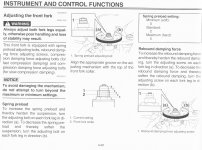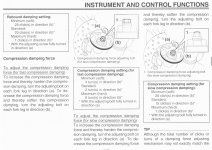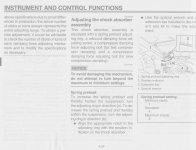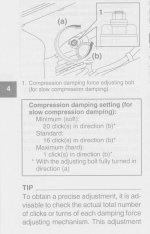You are using an out of date browser. It may not display this or other websites correctly.
You should upgrade or use an alternative browser.
You should upgrade or use an alternative browser.
Suspension Terminology - 2 clicks out
- Thread starter justride
- Start date
"Clicks out" is "out from closed" i.e. out from the firmest setting. Normally, turn the relevant adjuster all the way clockwise (closed), then back out the specified number of clicks. There can be exceptions, but the factory service manual (or the manual for the aftermarket suspension component that you have) should explain those.
justride
Well-known member
Suggested Sport Bike Motorcycle Suspension Settings
Sport Rider's setup recommendations for every motorcycle tested from 1997
You can start there, but in my own case (2004 ZX10R) what I have ended up with is nowhere close to their suggestions. I suspect their set-ups were established on a smooth southern-California racetrack. Cratered and pockmarked and frost-heaved Canadian roads (and tracks!) need more compliance.
They give preload suggestions, but don't say how much the rider that tested the bike weighed... ?Suggested Sport Bike Motorcycle Suspension Settings
Sport Rider's setup recommendations for every motorcycle tested from 1997www.cycleworld.com
justride
Well-known member
Rider's "weight" is addressed by setting the sag, with the spring preload.
Until you get the sag right, nothing else will work as designed.
I strongly suggest you learn some more about what you're trying to do before you go blindly changing stuff.
A good source is the RaceTech bible.
Until you get the sag right, nothing else will work as designed.
I strongly suggest you learn some more about what you're trying to do before you go blindly changing stuff.
A good source is the RaceTech bible.
Priorities:
First tires
Second rider-aboard sag
Third geometry (ride heights - affects rake, trail, swing-arm pivot height which affects grip on corner exit, etc)
Fourth spring rates (including fork-oil level, which is a spring-rate contribution)
Fifth go back and fix the geometry and the sag if sorting out the spring rate messed these up
Sixth damping-clickers
Seventh internal damper valving
Then it's iterating and problem-solving ...
First tires
Second rider-aboard sag
Third geometry (ride heights - affects rake, trail, swing-arm pivot height which affects grip on corner exit, etc)
Fourth spring rates (including fork-oil level, which is a spring-rate contribution)
Fifth go back and fix the geometry and the sag if sorting out the spring rate messed these up
Sixth damping-clickers
Seventh internal damper valving
Then it's iterating and problem-solving ...
Mad Mike
Well-known member
I get my suspension set by racers. As much work as I have done on building/rebuilding bikes, this seems like an art.Priorities:
First tires
Second rider-aboard sag
Third geometry (ride heights - affects rake, trail, swing-arm pivot height which affects grip on corner exit, etc)
Fourth spring rates (including fork-oil level, which is a spring-rate contribution)
Fifth go back and fix the geometry and the sag if sorting out the spring rate messed these up
Sixth damping-clickers
Seventh internal damper valving
Then it's iterating and problem-solving ...
When Speedworx was local, I’d bring their guy a coffee and in 10 minutes he would dial me in. It would be great if a GTAM track guy offered this service, I’ll bet you could get 20 bikes a day at $40/bike.
kurtrules
Well-known member
I get my suspension set by racers. As much work as I have done on building/rebuilding bikes, this seems like an art.
When Speedworx was local, I’d bring their guy a coffee and in 10 minutes he would dial me in. It would be great if a GTAM track guy offered this service, I’ll bet you could get 20 bikes a day at $40/bike.
I'd be the first to line up..
Look at the list Brian posted.I’ll bet you could get 20 bikes a day at $40/bike.
That will get you a " neutral" setup, where you START to setup for an individual rider's personal "style" or preference.
It is a lot of time, nobody is doing this for $40.
... and then once you get "neutral" it is up to you to communicate to the tuner what needs to change.
Saying ' The front ends mushy' or "It doesn't handle right" doesn't mean much. I can set up the bike to the way I want it, but unless you can tell me, in language I can understand, what you need changed, it's all guess work.
Which means: Even if you're not swinging the wrenches in a suspension "tune up", you should know what compression damping, rebound damping, and spring rates DO. What the function of these are and what changes when you change them.
It takes me about half a day to get a "ballpark" setup for MY bike, assuming I have springs for it.
I have no idea how long it would take me to setup YOUR bike.
blackcamaro
Well-known member
I don’t mess with my street bike stuff much but dirt bikes I do. The clickers are there for a reason and your not going to hurt much trying to dial it in.
Write down your current setting. It might end up being your preference
Get a buddy or two to help you set the sag/preload. I’m not up to speed on SS bikes but I believe your going to be looking for about 1/3 of total travel as your sag. Ideally you compare static sag to race sag to confirm you have the right springs rates. You can just cheat and check racetech’s spring calculator to see if your weight is in the ballpark for the OEM springs.
Grab a flat blade, set your tire pressures and head out to a road you can ride over and over as you make adjustments. You want to be on the same road so you can feel the difference on the same bumps, corners etc.
At this point I set everything to middle of the adjustment range. Got 20 clicks of adjustment set it at 10. I start on the forks with compression. Make a big change so you can feel it. Go 5 harder or softer. Then do the opposite. What felt better? Now you know what side of the mid point you want to be on. Go back to the mid point and then make smaller adjustments in the direction you found you wanted to go. Once the feel you liked starts to go away back off one or two clicks. Then repeat the same for rebound. I don't like the harder/softer wording in the manual for rebound, (-) less rebound damping is the forks/shock returning to their position quicker (+) more rebound dampening is slowing how quick they return.
Repeat for the shock.
Remember to write down your current settings. That way if you get messed up or head the wrong direction you can quickly just put it back the way it was.
I'm not saying I get the perfect setup but I do get my bikes better then just leaving them alone. It's also free to mess around with so no reason not to.
Write down your current setting. It might end up being your preference
Get a buddy or two to help you set the sag/preload. I’m not up to speed on SS bikes but I believe your going to be looking for about 1/3 of total travel as your sag. Ideally you compare static sag to race sag to confirm you have the right springs rates. You can just cheat and check racetech’s spring calculator to see if your weight is in the ballpark for the OEM springs.
Grab a flat blade, set your tire pressures and head out to a road you can ride over and over as you make adjustments. You want to be on the same road so you can feel the difference on the same bumps, corners etc.
At this point I set everything to middle of the adjustment range. Got 20 clicks of adjustment set it at 10. I start on the forks with compression. Make a big change so you can feel it. Go 5 harder or softer. Then do the opposite. What felt better? Now you know what side of the mid point you want to be on. Go back to the mid point and then make smaller adjustments in the direction you found you wanted to go. Once the feel you liked starts to go away back off one or two clicks. Then repeat the same for rebound. I don't like the harder/softer wording in the manual for rebound, (-) less rebound damping is the forks/shock returning to their position quicker (+) more rebound dampening is slowing how quick they return.
Repeat for the shock.
Remember to write down your current settings. That way if you get messed up or head the wrong direction you can quickly just put it back the way it was.
I'm not saying I get the perfect setup but I do get my bikes better then just leaving them alone. It's also free to mess around with so no reason not to.
Aens
Well-known member
$40 USD trackside. Watching a ton of Dave Moss Tuning videos on youtube to acquaint myself. Never knew I needed to till I bought a "track prepped" bike and rode it without validating the settings.Look at the list Brian posted.
That will get you a " neutral" setup, where you START to setup for an individual rider's personal "style" or preference.
It is a lot of time, nobody is doing this for $40.
Nothing quite as terrifying as trying to lean a bike that has it's rear preload collar overtightened by at least 10 spins, with damping and rebound near maxed. I wasn't sure if I was riding a bike or a bucking bull but definitely peed myself as it tried to highside me multiple times.
Thankfully, its mostly sorted now. Moral of the story. Suspension setup is serious business and if someone has no clue what they are doing, they can send you to the hospital.
Priller
Well-known member
True, but there are often suspension guys who'll do a very basic setup trackside for a reasonable price. You'll get your sag/preload done, and then valving in the ballpark for your springs based on bouncing the forks and seat. It's not going to set any lap records, but it'll get most mediocre riders a lot closer than sticking with stock or mucking about themselves without a reasonable baseline (especially considering how easy it is to get totally lost when flying blind). From there, you can start playing around to see what works.Look at the list Brian posted.
That will get you a " neutral" setup, where you START to setup for an individual rider's personal "style" or preference.
It is a lot of time, nobody is doing this for $40.
Andrew Trevitt's Sportbike Suspension Tuning and Paul Thede's Race Tech Motorcycle Suspension Bible are great resources to build on as well...
One other small thing. If we are talking about OEM forks and shocks (and steering dampers), the damping clickers are often "dumbed down" by the original manufacturer so that you can't adjust them out of the range that the OEM decided that you were allowed to adjust within. Closing the damping needle doesn't actually close the valve (or it does, but there is a bypass around it that deliberately leaks like a sieve). Opening it doesn't open it enough to get you in trouble. I call those "non-adjustable adjustments". It also means that doing the above-mentioned exercise with setting clickers in the middle of the range and then making large changes to see what difference it makes ... might not accomplish much. Fixing this requires revalving ... or tossing the stock parts and replacing them with good aftermarket bits.
Closing a damper adjustment on a genuine Ohlins shock or fork cartridge definitely makes a difference.
Closing a damper adjustment on a genuine Ohlins shock or fork cartridge definitely makes a difference.
TK4
Well-known member
If you don't know what you're doing, then head out to Buckhorn and get it done right -

 acceleratedtechnologies.ca
acceleratedtechnologies.ca

Home - Accelerated Technologies
Services Lowering SAG & Set Up Track Preparation Fork Service & Tuning General Service Shock Service & Tuning Parts Accelerated Technologies Welcome to Accelerated Technologies. As Motorsports Suspension specialists we specialize in suspension of all kinds including street bikes, road racing...
 acceleratedtechnologies.ca
acceleratedtechnologies.ca
Priller
Well-known member
I've also heard that some stock valves only really adjust damping over the first four or five clicks out, anything after that doesn't change much...One other small thing. If we are talking about OEM forks and shocks (and steering dampers), the damping clickers are often "dumbed down" by the original manufacturer so that you can't adjust them out of the range that the OEM decided that you were allowed to adjust within. Closing the damping needle doesn't actually close the valve (or it does, but there is a bypass around it that deliberately leaks like a sieve).
And I believe we've talked before about the Ohlins steering damper fitted to my second-gen ZX-10R, which was gimped by Kawasaki to not allow much adjustment at all..
TK4
Well-known member
Ohlins, like Brembo build to whatever price point the customer wants.And I believe we've talked before about the Ohlins steering damper fitted to my second-gen ZX-10R, which was gimped by Kawasaki to not allow much adjustment at all..
As I recall, the Ohlins steering dampers and Brembo master cylinders on some model GSXRs were no screaming hell from the factory either.
Ohlins, like Brembo build to whatever price point the customer wants.
... and to whatever specifications the customer wants. In the case of the above-mentioned gen 2 ZX10R, they gimped the steering damper to avoid having people fall over in parking lots because they cranked up the steering damper too far. The orifice inside the steering damper is intentionally different in order to prevent people from doing that.



















